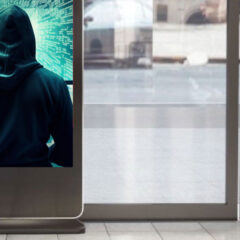How Digital Signage Supports the Customer Journey

To paraphrase Mark Twain, reports about the death of in-store retail sales have been greatly exaggerated. Despite steady increases in e-commerce revenues, brick-and-mortar outlets still command the vast majority of retail sales. According to Department of Commerce figures, in-store sales accounted for more than 80 percent of a record $4.55 trillion in retail sales in 2021. In fact, brick-and-mortar store sales last year grew faster than e-commerce sales for the first time in retail’s history.
Those stats may surprise you. Most Americans have become very comfortable with online shopping because it offers undeniable advantages over in-store shopping. It’s more convenient, prices are often better and there’s a virtually unlimited inventory.
However, there’s one area in which online outlets simply can’t compete with their physical counterparts — the customer experience. For many people, going to the store is not just a task but an important social activity. Psychologists even find that “retail therapy” helps people relieve stress and improve their mood. The tactile experience is also meaningful. Some people simply want to see, touch and feel the items they are thinking about buying.
Digital signage contributes to an appealing customer experience by creating a bridge between digital and physical sales channels. Signage solutions provide the best of both worlds by offering access to online resources while also supporting the personal touch of an in-store experience.
Here are some of the ways signage can be used to support in-store shoppers during the three main phases of the customer journey:
AWARENESS
The initial stage of the journey is when prospective customers acknowledge that they have a problem or a need and begin doing general research and gathering information about how to address the issue.
- Signage’s role: Digital signage is an effective way to provide customers with information about your company and products. Retailers can use their signage systems to display product research, advice, testimonials and recommendations to guide customers to products or services that best fit their needs. Unlike print signage that pushes advertising messages, signage pulls customers in with video and weaves in relevant, valuable content. This makes your messages more welcome, attractive and influential while increasing brand awareness and customer retention.
CONSIDERATION
At this point of the journey, customers have narrowed down their options and are actively comparing and evaluating products to identify an ideal combination of price, quality and functionality.
- Signage’s role: The ability to update, modify and rotate messaging quickly and efficiently makes it easier to provide customized content about specific products. Signage can also create seamless connections to a retailer’s online resources where shoppers can take a look at product information, the latest marketing campaigns, social media feeds and more. Retailers can also use signage to display new products and promote discounts that guide the customer’s ultimate purchasing decision.
DECISION
At this stage, customers have done their research, evaluated their options and are more ready to make a purchase. Factors such as price and features can still sway the decision, as can more subjective influences such as brand loyalty.
- Signage’s role: One recent survey found that 80 percent of customers are actively looking for deals when they go to the store. Signage at the point of sale can have a strong influence on a customer’s final purchasing decision. Coupons, discounts and other promotions not only provide strong incentives but can also help build customer loyalty and promote return visits. Signage also provides upsell and cross-sell opportunities at checkout.
More Insights
-
Digital Experiences, SageVIEW Approach
How Digital Signage Boosts Workforce Productivity
-
Digital Experiences
How Digital Signage Can Play a Role in Reducing Workplace Stress
-
Digital Experiences
7 Steps for Upgrading and Enhancing a Digital Signage Network
-
Digital Experiences
Why You Should Make Digital Signage Security a High Priority




